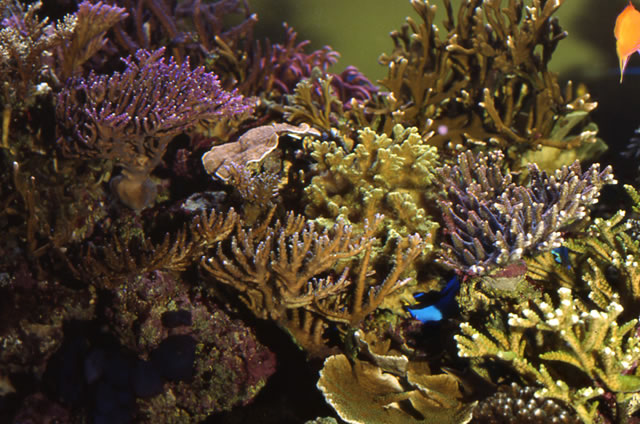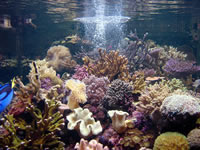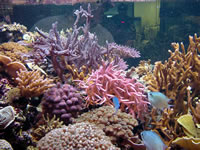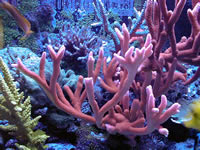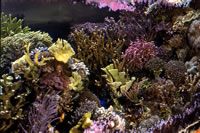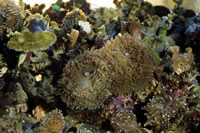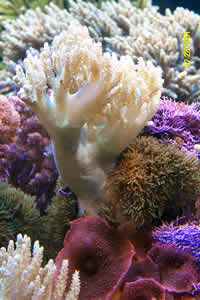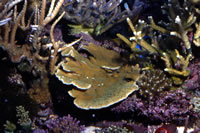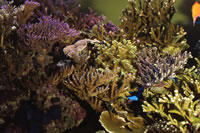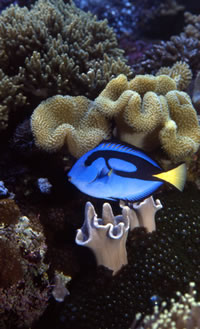
|
|
|
Bob Nell's Reef
Tank
I would like to express my thanks to those responsible for featuring my tank on Reef Central. Background:I started too long ago with a pair of guppies, soon increasing to 100 guppies, etc. After being fishless for many years, I became intrigued with the fascinating creatures of the marine world. I took the plunge in 1993 with a 75 gallon fish-only setup, operated using an underground filter without a skimmer. I still have my first clownfish from this setup. By this time I was hooked, but still without much knowledge. To be brief, I subsequently went to a Dutch setup (similar to wet/dry bacteria filter) reef before what I thought would be my final fix, a 120 gallon algae scrubber system set up in 1997. Just prior to this, I made the best move of all: joining the Pittsburgh Marine Aquarium Society (PMAS.org). The many friendships, support and knowledge base proved invaluable. At the end of 1998 it was obvious that most of the corals were outgrowing the 120. Realizing that I now enjoyed the reef hobby more than one of my former passions, shooting pool in my basement, I decided to set up a "big" reef tank. The following is a description of that system.
The acrylic tank is in the center of the room, replacing the pool table. It is 72" x 48" x 30," having a capacity of 500 gallons with a 100 gallon sump. Three sides are viewable. One side is dark with an 18 inch surface overflow. There is a 5" by 16" by 24" external overflow box, which is plumbed with three 2" drains. The returns include two bottom, one split side, two split top and one single top line, all of which are 1". The stand is built similar to a deck with 2 x 6 and 4 x 4 supports and two sheets of 3/4" plywood on top and one sheet approximately 4" above the floor. An insulation board was placed between the tank and plywood. There is 24" of clearance, but 30" between the joists. The finish is veneer. The hood was built out of 12" veneer. The front and rear panels can be removed via slots at each end. All finish was stained and sealed with a marine finish. The majority of the live rock was placed on a PVC skeleton, which eliminated the need for base rock. This created a large cavern and a higher contour at the overflow end of the tank.
The original design consisted of three 1800 Mag Drive pumps. I realized more circulation was needed, but did not want to use powerheads. I decided to use Seaswirls, which are hidden by the hood. Two additional 1800's and a single 1200 Mag Drive were plumbed via the overhead returns. Gross pump capacity is 10,200 gallons per hour. With head reduction, the actual flow is probably closer to 6,500 gallons per hour.
Poly-Bio-Marine Kold Ster-il has been used from initial setup. A 50 gallon reservoir is used, which has 15 lb. of aragonite calcium reactor media for a slight alkalinity boost. Instant Ocean salt has been used since initial setup. 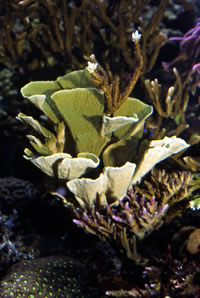
Korallin calcium reactor sized for a 1600 gal capacity with ultra pure media. Additives:Some experimenting has been done.
A variety of flake, pellet and frozen.
Filter bags: 2 x 5 min per week
A variety of corals that offer just about every color and shape imaginable.
Lessons Learned: The cute little Hippo tangs that
started out quarter size and I even questioned whether they
were too small, have grown to 5", and have learned
to enjoy eating xenia, zoanthid polyps and some sarcophyton
and sinularia polyps. Feel free to comment or ask questions in the Reefkeeping online Tank of the Month forum on Reef Central or in this thread in the main forums on Reef Cental.
|


